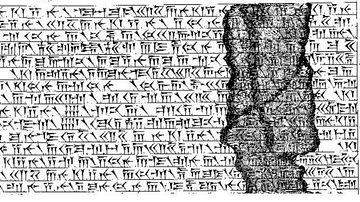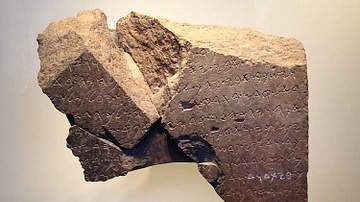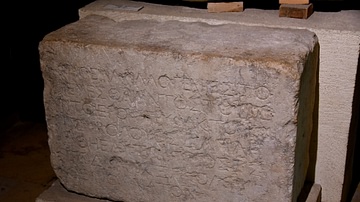Illustration
"During the reign of King Hezekiah of Juda (c. 725-697 BCE), the Assyrians completed the conquest of Israel, and the city of Juda was left as the only surviving independent state in the region. To ensure that the capital would not suffer any shortage of water in times of siege, the King built a tunnel of some 533 meters (improving an earlier version) between the spirng of Gihon and the pool of Siloam at Jerusalem. In the year 1880 CE, while a boy was bathing in the pool of Siloam in Jerusalem, he came across an inscription, few yards away from the mouth of the tunnel which brought water to the pool. The inscription (six lines in Hebrew), covered to the lower part of the panel and the upper section, was left open, probably for the illustration of the boring operation. It seems that two groups of workers began from opposite ends and hacked their way through limestone rock to make the tunnel. It is assumed that the operation must have taken at least six months, and until they were able to hear each other's pick-axes, the workers lost their direction and dug a large S-shaped path, covering the distance between the spring and the pool. At most of the places, the tunnel is about six feet and the work must have been done in a stooping or a crouching position in the dim glow of lamps or torches and in low air supply. The inscription was transferred to Istanbul in the year 1882 CE. The water tunnel is still functioning and is known as Ain Silvan, and inscription is known as the Siloam inscription* (also Shiloah inscription or Silwan inscription). Limestone. Circa 700 BCE. From the Siloam Tunnel at Jerusalem, in modern-day State of Israel. (Museum of Archaeology, Istanbul, Turkey).
*Pasinli, Alpay. Istanbul Archaeological Museums. Istanbul: A Turizm Yayınları, 2012.
About the Author
Cite This Work
APA Style
Amin, O. S. M. (2018, June 04). The Siloam Inscription from Jerusalem. World History Encyclopedia. Retrieved from https://www.worldhistory.org/image/8766/the-siloam-inscription-from-jerusalem/
Chicago Style
Amin, Osama Shukir Muhammed. "The Siloam Inscription from Jerusalem." World History Encyclopedia. Last modified June 04, 2018. https://www.worldhistory.org/image/8766/the-siloam-inscription-from-jerusalem/.
MLA Style
Amin, Osama Shukir Muhammed. "The Siloam Inscription from Jerusalem." World History Encyclopedia. World History Encyclopedia, 04 Jun 2018, https://www.worldhistory.org/image/8766/the-siloam-inscription-from-jerusalem/. Web. 17 Jul 2025.








